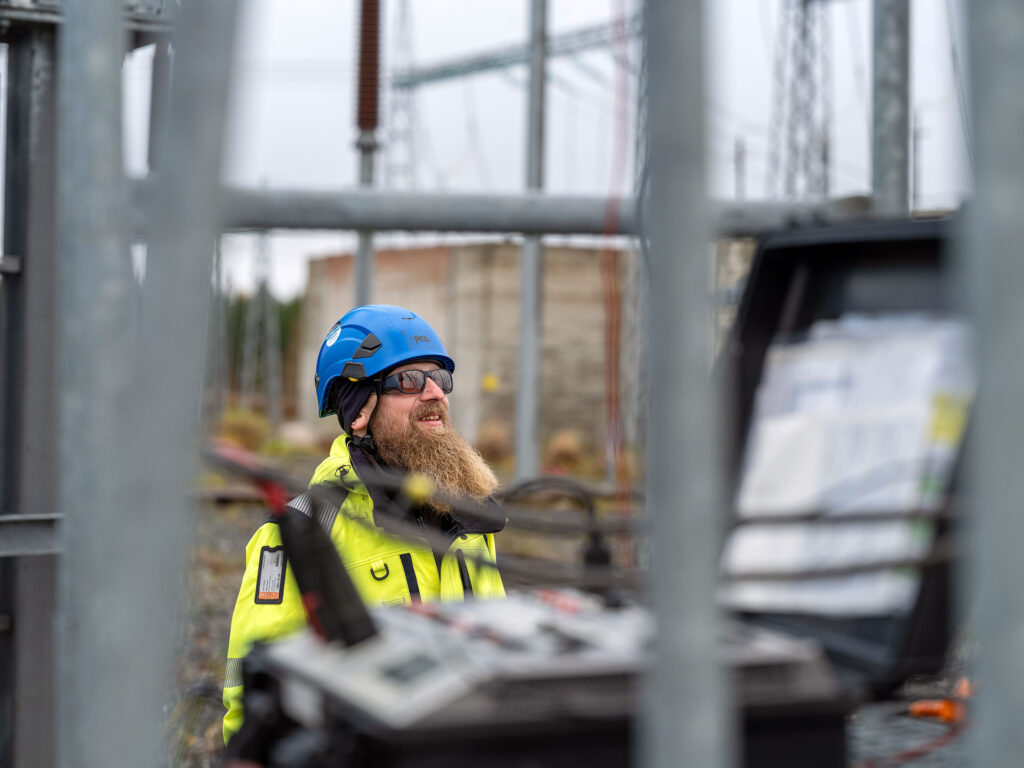Fingrid has 130 substations in Finland at the moment, and the country is divided into ten maintenance districts. The operation and condition of substations are monitored using SCADA, condition monitoring, and video surveillance systems. In addition, they undergo various on-site technical, environmental, and safety inspections annually.
Four service providers currently handle the basic maintenance of substations in the ten maintenance districts. All in all, Fingrid works with approximately 80 installation technicians and supervisors through its service providers.
On an autumn morning, Mika Oilinki, Switchgear Technician from Oulu, visits the Omexom office to pick up the maintenance supplies and personnel lift he will need for the day.
Oilinki enjoys his work, as his long career history proves: after graduating as an electrician in 1996, he joined Imatran Voima. His next job was in Fingrid’s regional control centre in Oulu 1998. The regional control centres have since been centralised in Helsinki. Oilinki moved to Fortum and eventually ended up at Omexom following some mergers and acquisitions.
“The best thing about my job is how varied my days are because I always work at different substations. I like being in the fresh outdoor air. Well, working at temperatures of -30°C may not be entirely comfortable, but, luckily, it rarely gets that cold.”
Once the day’s work tools are in the maintenance van, he heads to a nearby substation.
Work nearby and further afield
Substations are typically located far from population centres. The electrical areas at substations are fenced off, and third parties should not enter them. The substations are mostly transformer and switching stations using a wide range of technologies.
Oilinki’s region is Northern Finland, so he sometimes needs to travel long distances and stay at hotels
“On average, I need to travel every other week, so travelling is a part of the job. I mainly work during the day, but if a fault occurs, I may end up working into the evening,” says Oilinki.
His job also requires him to be on standby one week in every five weeks, so he needs to be available 24 hours a day and visit sites if necessary.
He recalls one particular case from his standby work: an alarm sounded, reporting that a substation’s reactor coil had tripped off the network. Oilinki went to check and found the reactor coil in flames. The control centre called the fire brigade.
“The alarm sounds roughly once a week when I am on standby. The most common cause is a device failure. For example, a circuit breaker may have tripped.”

Remote monitoring is not enough
When high-voltage switchgears are maintained, the work location is first de-energised and earthed to ensure safety. This is done in coordination with the switching supervisor at the Main Grid Control Centre during a phone call.
The Main Grid Control Centre monitors activity at the substation, controls the switchgear remotely, and sets various automation configurations. However, inspections and maintenance must be performed at the substation.
Today, Oilinki’s task is disconnector maintenance. A disconnector is a device that reliably separates two parts of the electricity network.
His work can also include fault repairs and local switching when the main grid’s switching state changes.
As the working day nears its end, his attention turns to reporting in Fingrid’s asset management system. Oilinki enters the reporting information required by the application, such as the results of condition monitoring measurements and the checks performed.
Today, he finishes work on time. Oilinki is also an outdoor person in his leisure time. In the winter, he enjoys skiing and snowmobiling. In other seasons, he goes mountain biking, motorcycling, or boating. But today, he spends the evening at home with his family.







